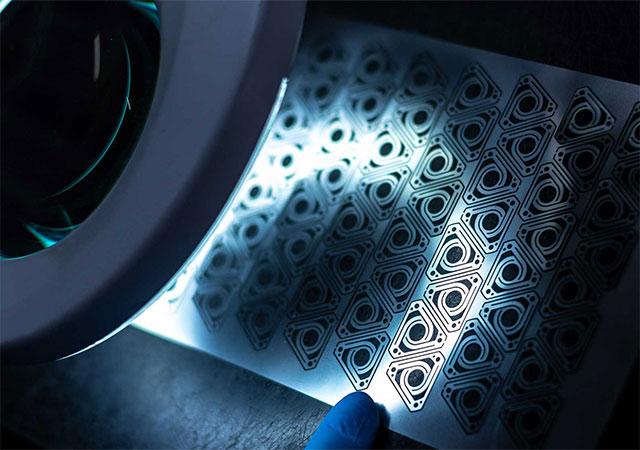
1. Cleaning process before metal etching:
Stainless steel or other metal etching before the process is cleaning treatment, the main role is to remove dirt, dust, oil stains on the surface of the material. The cleaning process is the key to ensure that the subsequent film or screen printing ink has good adhesion to the metal surface. Therefore, it is necessary to completely remove the oil and oxide film on the surface of metal etching. Degreasing should be determined according to the oil pollution of the workpiece. It is best to make electric degreasing before screen printing ink to ensure degreasing effect. In addition to the oxide film, the best etching solution should be selected according to the metal type and film thickness to ensure surface cleanliness. It must be dried before screen printing. If you have moisture.
2. Stick dry film or screen printing sensitive adhesive layer:
According to the actual product material, thickness, the exact width of the figure, determine the use of dry film or wet film screen printing. For products of different thickness, factors such as etching processing time required for the product graphics should be considered when applying the photographic layer. Can make thicker or thinner photosensitive adhesive layer, covering performance is good, metal etching produced high definition pattern.
3. drying:
After the film or roll screen printing ink is completed, the photosensitive adhesive layer needs to be thoroughly dried in preparation for the exposure process. At the same time to ensure that the surface clean, no adhesion, impurities, etc.
4. This process is an important process of metal etching, and the exposure energy will be considered according to the thickness and precision of the product material. This is also the embodiment of the technical ability of etching processing enterprises. The exposure process determines whether etching can ensure better size control accuracy and other requirements.
5. Development:
The metal etching plate surface of the photosensitive adhesive layer after exposure, the pattern of the adhesive layer exposure after curing. After that, the unwanted parts of the pattern, the parts that need to be corroded, are exposed. The development process also determines whether the final size of the product will meet the requirements. This process will completely remove the unwanted photosensitive adhesive layer on the product.
6. Etching or etching process:
After the product prefabrication process, the chemical solution will be etched. This process determines whether the final product is up to snuff. This process involves the concentration of etching solution, temperature, pressure, velocity and other parameters. The quality of the product needs to be determined by these parameters together.
7. Remove:
After etching, the product surface is still covered with a layer of photosensitive adhesive, which needs to be removed. Because the photosensitive adhesive layer is acidic material, so most of the expansion by acid-base neutralization method. After overflow cleaning and ultrasonic cleaning, remove the surface of the photosensitive adhesive layer, to prevent photosensitive adhesive residue.
8. Detection:
After taking the film, the follow-up is testing, packaging, and the final product is confirmed to meet its specifications.
Asset Metal Technology focus on providing and developing one stop metal solution in CNC, etching, punching, anodizing manufacturing which widely used in field of toys, electronics, intelligent component, pilotless aircraft and vehicle.


 +8613538580966
+8613538580966

